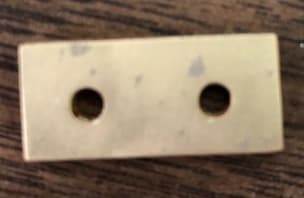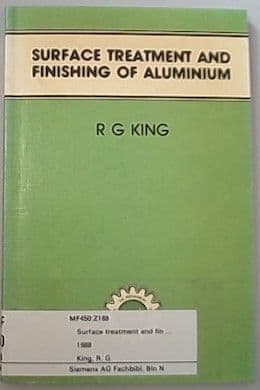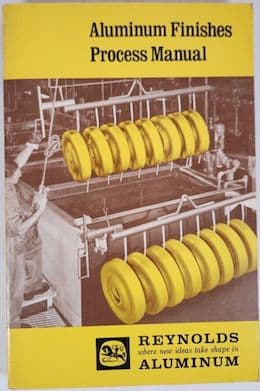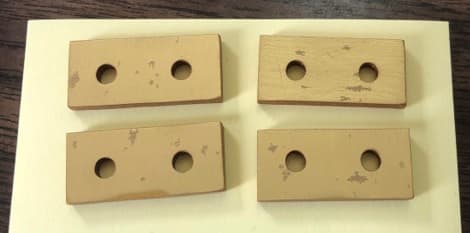
-----
Flaking anodize on Alloy 2024 aluminum
Q. We are having issues with our dyed parts on 2024 aluminum. The Dye keeps flaking off along with some of the anodize we believe. We've tested the Voltage and its consistent during the runs. We use 50% sodium hydroxide in all tanks requiring pH balancing including the dye tanks. Could this be the issue?
Joey rothChem La Tech/ Anodizer - New port Richey, Florida
January 30, 2024
A. Hi Joey,
The dye is IN the anodizing rather than on it; so if the dye is flaking off, yes, the anodizing is flaking off.
Luck & Regards,

Ted Mooney, P.E. RET
Striving to live Aloha
finishing.com - Pine Beach, New Jersey
Ted is available for instant help
or longer-term assistance.
A. Hi Joey,
If you're running Azo dyes (and most of this info is based on that assumption), the pH adjust solutions of choice would be ammonium hydroxide and acetic acid.
Double check your tech sheets for the manufacturer recommendation.
Also of note- your dyes should be significantly buffered, and in my experience with azo dyes, tend to drift UP- if you're having to adjust upwards, really look at the steps between anodize and dyeing. For example, are you using a weak nitric dip to help purge the viscous sulfuric before final rinse so it doesn't acidify the dye tanks? I'm not sure if others have observed this as well, but in my experience having to raise the pH of a dye tank is rare, and a cause for, if not alarm, at least a raised eyebrow.
Whether or not it's directly related to your current chipping issue, it's something to keep in mind.

Rachel Mackintosh
Lab Rat / WWTF - Greenfield MA
June 18, 2024
There is a lot more than Voltage that comes into play when troubleshooting your anodizing.
Temperature throughout the anodizing process, even the temperature of your rinse before and after colouring come into play. In your case, if you take parts from a low temperature anodizing bath and move it to a very high temperature dye bath, you may be facing crazing of even spalling/flaking due to the thermodynamics that take place in the base metal versus the anodizing layer.
When the two metals are either rapidly cooled or heated, they expand or contract at different rates, this can cause crazing and even flaking or spalling.
You mention Voltage, but don't mention your Current Density. Too much power can be part of the cause if the 2024 has pockets of impurities, something it shouldn't! But seeing that over the last couple of years (Basically since Covid hit), aluminium quality has dropped and prices has gone up. Especially with less reputable aluminium providers.
Your acid concentration, unless you run completely absurd numbers, is probably not the issue, unless combined with say, strange power numbers.
Ordinarily, anodizing wouldn't "flake off" unless there is something very wrong with either the aluminium or the process. But if you are certain this is the case, and it is not a matter of white spots. (Google this, it is a much more common topic in the anodizing industry than flaking. Especially look for articles by Anne Deacon Juhl, Pinakin Patel and Mark Jozefowicz)
If possible, a picture using a normal camera or phone, as well as one taken under a microscope would be very helpful.
- Horsens, Denmark
July 1, 2024
⇩ Related postings, oldest first ⇩
Q. We have some black anodized 2024-T851 piece parts which exhibit flaking of the anodize, exposing the base metal. The parts see a thermal cycle of -50C to 160C with a ramp rate of 3C/min. We have used this cycle previously and have never experienced flaking. Could this be attributable to poor surface preparation prior to anodize and/or improper anodizing conditions?
Bill Park1999
Multiple threads merged: please forgive chronology errors and repetition 🙂
Q. We had a problem with anodizing and dying some parts in gold. There appears to be "corrosion" marks on the finished surface.

Material: 2024T3 ALCLAD
Sulfuric Acid Type II anodizing
I wonder what variables may have caused this problem and how I should investigate / validate each of the variables.
- Calgary, Alberta
April 23, 2021
for Shops, Specifiers & Engineers

avail from eBay, AbeBooks, or Amazon

avail from eBay, AbeBooks, or Amazon

avail from eBay, AbeBooks, or Amazon

avail from eBay, AbeBooks, or Amazon

avail from eBay or Amazon
(as an Amazon Associate & eBay Partner, we earn from qualifying purchases)
A. Hi Jason. Unfortunately that photo is poorly focused so it's hard to say whether you have flaking, areas of pitting, or whatever. Based on the location of the discoloration it doesn't look like burning. From what I can see I'd probably call it "splotchy"; it's possible the part just wasn't clean enough. Maybe you can measure the anodizing thickness in the splotchy spots vs. the other areas?
One way to answer your question of what to investigate / validate would be to say "Why do you want to reject this part?". I am not saying the part is satisfactory by any means, I'm saying that very clearly and specifically annunciating exactly what you feel is wrong with it can be an essential step in fixing it.
Luck & Regards,

Ted Mooney, P.E. RET
Striving to live Aloha
finishing.com - Pine Beach, New Jersey
Ted is available for instant help
or longer-term assistance.
April 2021
Q. Thank you Ted. This part was rejected first time by the customer when we first ran it. Then we reworked it and still got the same defect. Here is a better picture.:

- Calgary AB
April 26, 2021
A. Jason.
2024 is a problem alloy to anodize, I'm not saying it cannot be done but problems with burning and accepting dye are always a factor. My general rule for 2024 is stay away from etching as much as possible, if possible don't etch. Use a good deox and stay longer in it. One last thing, a slow ramp to the correct current 8-12 min is always a help.

Drew Nosti, CEF
Anodize USA
Ladson, South Carolina


Aluminum How-To
"Chromating - Anodizing - Hardcoating"
by Robert Probert
Also available in Spanish
You'll love this book. Finishing.com has sold almost a thousand copies without a single return request :-)
A. Are you sure it is 2024. Did it turn black in the alkaline etch? Do you know if has been heat treated, hence disrupting the copper coming out of alloy? Do we have floating soil in the anodizing post rinsing that can enter the pores and limit dye adsorption?

Robert H Probert
Robert H Probert Technical Services
Garner, North Carolina

Q. Thank you Robert. According to our customer, the material is 2024-T3 ALCLAD. It did look blackish after etching. We don't know if it was heat treated or not before the customer sent the part to us. The post anodizing rinse appears to be clean without floating soil if you are referring to floating soil to naked eyes. We anodized and dyed another part (of same material according to the customer) on the same load from the same customer and had no such a problem.
Jason Chow- Calgary, AB
Sorry! Site is temporarily read-only as we deal with
intense Chinese hacking crashing e-mail servers.
